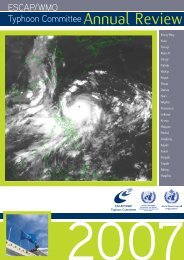TCAR - Typhoon Committee
TCAR - Typhoon Committee
TCAR - Typhoon Committee
Create successful ePaper yourself
Turn your PDF publications into a flip-book with our unique Google optimized e-Paper software.
on that day. Koppu intensified into severe tropical<br />
storm then typhoon rapidly the next day. It made<br />
landfall over western Guangdong on 15 September<br />
and weakened into a severe tropical storm and was<br />
rapidly downgraded to tropical depression intensity<br />
before dissipating over Guangxi later.<br />
KETSANA (0916) formed as a tropical depression<br />
over the western North Pacific east of the Philippines<br />
on 25 September and moved generally westwards.<br />
It intensified into a tropical storm the next day.<br />
After crossing the Philippines, Ketsana entered the<br />
South China later on that day. Ketsana intensified<br />
into a severe tropical storm and then further into a<br />
typhoon on 28 September. It made landfall on Viet<br />
Nam soon afterwards, then weakened into a severe<br />
tropical storm. It was rapidly downgraded into tropical<br />
depression intensity on 30 September and later on<br />
dissipated in Viet Nam.<br />
PARMA (0917) formed as a tropical depression<br />
over the western North Pacific south of Guam ON<br />
27 September and moved west-southwestwards. It<br />
intensified into a tropical storm and a severe tropical<br />
storm on 29 September as it turned to move westnorthwestwards.<br />
Maintaining its northwesterly track,<br />
it was upgraded into a typhoon on 30 September over<br />
the sea east of the Philippines. Parma crossed the<br />
northern part of Luzon on 3 October and remained<br />
lingering around this area for the following 6 days<br />
while diminishing its intensity. Parma weakened into<br />
a tropical depression over the South China Sea on 10<br />
October. While moving westwards, it re-intensified to<br />
tropical storm the next day. Turning to move westnorthwestwards,<br />
Parma crossed the Hainan Island<br />
and weakened into a tropical depression on 14<br />
October and dissipated later over Beibu Wan.<br />
MELOR (0918) formed as a tropical depression<br />
west of the Marshall Islands on 29 September and<br />
moved generally west-northwestwards. It intensified<br />
into tropical storm and a severe tropical storm the<br />
next day, then rapidly into a typhoon on 1 October.<br />
Maintaining its typhoon intensity and northwesterly<br />
track, Melor was gradually turning to move in the<br />
northeast direction. Melor made landfall over Honshu<br />
on 7 October with typhoon intensity, then it moved<br />
across the southern part of Honshu and transformed<br />
into an extra-tropical cyclone over the sea east of<br />
Hohshu on 8 October. It dissipated on 11 October.<br />
NEPARTAK (0919) formed as a tropical depression<br />
west of Saipan on 8 October and moved northnorthwestward.<br />
It intensified into a tropical storm<br />
the next day and turned to move northeastwards.<br />
<strong>TCAR</strong><br />
CHAPTER 2 - TROPICAL CYCLONES 2008<br />
Continuing its northeasterly track with accelerated<br />
speed, it became an extra-tropical cyclone on 14<br />
October.<br />
LUPIT (0920) formed as a tropical depression over<br />
the western North Pacific to the southeast of Guam<br />
on 14 October and moved west-northwestwards. It<br />
intensified into a tropical storm on 15 September and<br />
severe tropical storm then typhoon on 16 September.<br />
Lupit gradually turned to move slowly from northwards<br />
to generally westwards and weakened into a severe<br />
tropical storm on 23 October off the northeastern<br />
coast of Luzon. It then turned to move northeastward<br />
traversing the sea to the south of Japan. While<br />
accelerating along the northeasterly track, it became<br />
an extra-tropical cyclone on 27 October and dissipated<br />
in the area north of Aleutian Islands on 31 October.<br />
MIRINAE (0921) formed as a tropical depression over<br />
the western North Pacific east of Guam on 25 October<br />
and moved west-northwestwards while intensifying<br />
into tropical storm and severe tropical storm on 27<br />
October. It intensified further to a typhoon over the sea<br />
to the east of Luzon on 28 October. Mirinae crossed<br />
Luzon soon after weakening into a severe tropical<br />
storm on 30 October, and subsequently entered the<br />
central part of South China Sea. Moving westwards<br />
across the South China Sea, Mirinae weakened into<br />
a tropical storm and made landfall over the Viet Nam<br />
on 2 November, subsequently weakened further into<br />
a tropical depression and then dissipated.<br />
NIDA (0922) formed as a tropical depression over<br />
the western North Pacific to the southeast of Guam<br />
on 21 November and was moving slowly northwards.<br />
Turning to move northwestwards, Nida intensified into<br />
tropical storm on 23 November and a severe tropical<br />
storm on 24 November. Continuing its northwesterly<br />
track, Nida rapidly intensified into a typhoon. Nida was<br />
moving slowly again on 28 and 29 November. Then it<br />
moved west-northwestwards while weakening into a<br />
severe tropical storm on 1 December, a tropical storm<br />
on 2 December. It further weakened into a tropical<br />
depression on 3 December and dissipated over the<br />
western North Pacific northwest of Okinotorishima<br />
Islands.<br />
Of the 14 tropical cyclones affecting the Members<br />
of <strong>Typhoon</strong> <strong>Committee</strong> in 2009, disastrous events<br />
occurred in China, the Philippines and Vietnam. In<br />
China, there were totally 9 tropical cyclones landed<br />
on China. From the perspective of regional impacts,<br />
typhoon Morokot was most severe for its disastrous<br />
impacts in Taiwan with death toll more than 600<br />
people. It was reported that nearly 24 million people<br />
2009<br />
159

















